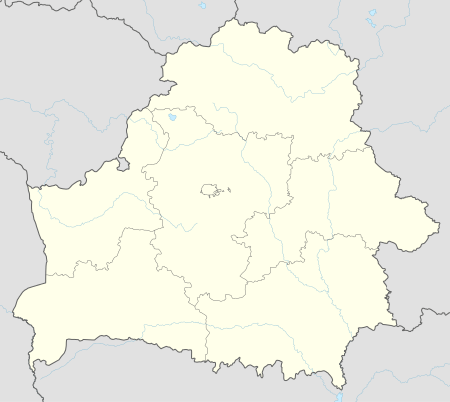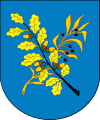Dzyarzhynsk
| Dzyarzhynsk Дзяржынск (Belarusian) Дзержинск (Russian) | |||
|---|---|---|---|
| |||
 Dzyarzhynsk | |||
| Coordinates: 53°41′00″N 27°08′00″E / 53.68333°N 27.13333°E | |||
| Country |
| ||
| Voblast | Minsk Region | ||
| Raion | Dzyarzhynsk Raion | ||
| Founded | 1146 | ||
| Population (2009)[1] | |||
| • Total | 25,164 | ||
| Time zone | EET (UTC+2) | ||
| • Summer (DST) | EEST (UTC+3) | ||
| Postal code | 222720 | ||
| Area code(s) | +375 1716 | ||
| License plate | 5 | ||
| Website | Official website | ||
Dzyarzhynsk or Dzerzhinsk; formerly Koydanava (Belarusian: Дзяржы́нск Dziaržynsk [dzʲarˈʐɨnsk]; Russian: Дзержинск, Polish: Kojdanów; Yiddish: קוידנוב, Koidanov), in the Dzyarzhynsk Raion of Belarus, is a city with a history dating to the 11th century.
History
In the Middle Ages, the village, then called Kojdanów, belonged to the Radziwiłłs, a Polish aristocratic family. It was known as Kojdanava / Koidanova townlet of Vilna Governorate of the Russian Empire.
Jews lived in Koidanova as early as 1620.[2]
Jewish community
Koidanova became the site of a new Hasidic Jewish dynasty in 1833 when Rabbi Shlomo Chaim Perlow (1797–1862) became the first Koidanover Rebbe.[3] He was succeeded by his son, Rabbi Boruch Mordechai Perlow (1818–1870), grandson, Rabbi Aharon Perlow (1839–1897), and great-grandson, Rabbi Yosef Perlow of Koidanov-Minsk (1854-1915), who was the last Koidanover Rebbe to live in the town. After World War I, the dynasty was moved to Baranovichi, Poland.[4]
In 1847, Koidanova had 2,497 Jewish inhabitants.[2] In 1897 the city had a total population of 4,744, of whom 3,156 were Jews.[5]
In May 1932 it was granted the status of a city and was renamed Kojdanaŭ (Belarusian: Койданаў), Russian: Koidanov. In June of that year it was renamed again as Dziaržynsk by the Communist authorities, in honor of Felix Dzerzhinsky (1877–1926), a famous Bolshevik creator and chief of the "Cherezvychainaya Komissija" (CHEKA) – the Soviet secret police -who was born in a Dziaržynava estate not far from the city.[2]
The city was the capital of the short-lived Dzierzynszczyzna Polish Autonomous District during 1932–38.[2]
World War II
It fell under German occupation during World War II. It was captured on June 28, 1941.
The Lithuanian Twelfth Schutzmannschaft (auxiliary police) Battalion's 1st Company, led by Lieutenant Z. Kemzura, massacred between 1,000 and 1,900 Jews from the city on October 21, 1941, shooting them and throwing them into a pit; many were buried alive.[6][7][8] As it is reported in The Complete Black Book of Russian Jewry: "For three hours the earth covering the mass grave would move; people still alive were trying to crawl out of their grave."[8] In July 1942, the Einsatzgruppen killed several thousand Jews in Koidanov.[9] The city was liberated by the Soviet Red Army on July 6, 1944.[2]
Modern day
In 1998, the city had 24,700 inhabitants.[10]
Now part of Belarus, the name Kojdanava (Belarusian: Койданава) is becoming popular again (it is the official name for the railway station of Dziarzhynsk), but the official name remains unchanged.
Geography
The highest point of Belarus, Dziaržynskaja Hara, is several kilometers from Dziaržynsk.
Transport
There is a railway road across the city from Minsk Passazhirsky to Baranovichi Polesskie.
There is only one bus route in Dziarzhynsk, that has 18 stops.
Notable residents
- Avrom Reyzen (1876–1953), Yiddish writer, poet, and editor
- Aharon Perlow (1839–1897) – third rebbe of Koidanov
References
- ↑ "World Gazetteer".
- 1 2 3 4 5 "Koidanova". Beljews.info. Retrieved August 20, 2011.
- ↑ Glassman, Deborah G. (2004). "Rabbonim, Rebbes, and Crown Rabbis, of Lyakhovichi". JewishGen. Retrieved 20 June 2012.
- ↑ Nadler, Allen (2010). "Koidanov Hasidic Dynasty". The YIVO Encyclopedia of Jews in Eastern Europe. Retrieved 20 June 2012.
- ↑ "Jewish population of Minsk uezd according to the 1897 Russian Census". beljews.info. Retrieved 20 June 2012.
- ↑ "Jewish Heritage Research Group in Belarus". Jhrgbelarus.org. October 21, 1941. Retrieved August 20, 2011.
- ↑ "Annual 7 Chapter 2". Simon Wiesenthal Center Multimedia Learning Center. Retrieved August 20, 2011.
- 1 2 The Complete Black Book of Russian Jewry. June 13, 2003. Retrieved August 20, 2011.
- ↑ United States Holocaust Memorial Museum (1995). Historical Atlas of the Holocaust. Macmillan / Simon & Schuster. ISBN 978-0028974514. See in Routes to Roots Foundation, Inc.
- ↑ "BELARUS: urban population". Populstat.info. Retrieved August 20, 2011.
External links
-
 Media related to Dziaržynsk at Wikimedia Commons
Media related to Dziaržynsk at Wikimedia Commons - Dzerzhinsk (in Russian)
- Photos on Radzima.org
- Map of Dziaržynsk
- "Why won't Britain jail this war criminal?; The UK has been a haven to 400 Nazi murderers. All but one have got away with it," The Observer, 2 September, 2001


